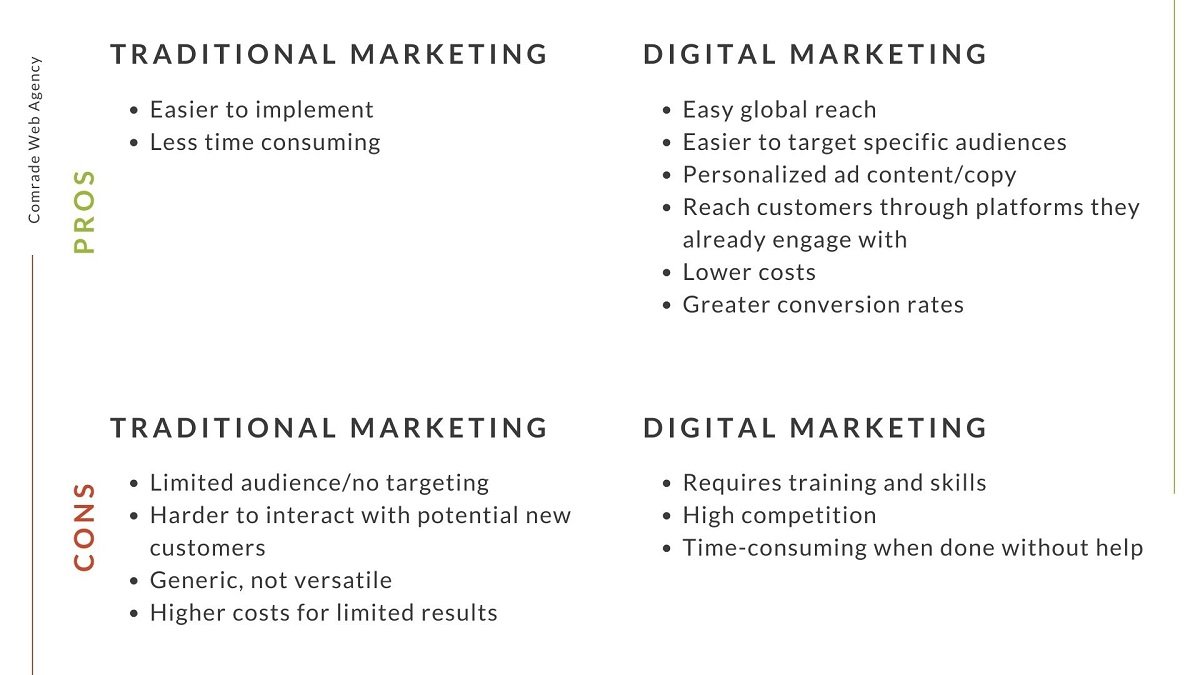Traditional marketing offers wide physical reach and easy audience understanding, while digital marketing is cost-effective and measurable. Traditional methods have limited interaction; digital platforms facilitate engagement and analytics.
In the evolving landscape of marketing, businesses constantly decide between traditional and digital strategies to reach their target audience effectively. Traditional marketing, encompassing print ads, billboards, and television commercials, is robust in building brand awareness and reaching local demographics. Meanwhile, digital marketing, through social media, SEO, email campaigns, and online content, empowers businesses with real-time data and targeting precision.
Engaging customers across various channels, developing a strong online presence, and tracking campaign performance have become indispensable. Marketers tailor their approaches by blending the tangible impact of traditional methods with the dynamic and interactive nature of digital marketing. This blend ensures a comprehensive approach to outreach, efficiently leveraging the unique benefits of each marketing style to achieve their objectives.

Credit: comradeweb.com
Evolving Landscape Of Marketing
The field of marketing never stands still. It shifts, grows, and transforms with the times. From the days of billboards and radio ads to the current digital dominance, marketing strategies have evolved drastically. Businesses today must understand the strengths and weaknesses of both traditional and digital approaches to stay ahead. Let’s dive deep into the roots of traditional marketing and the rise of the digital marketing revolution.
Traditional Marketing Roots
Traditional marketing is like an old tree with deep roots. It spans several methods that businesses have used for many years. These include:
- Print media such as newspapers and magazines.
- Television and radio spots that reach many people.
- Direct mail, like flyers and brochures, delivered to your door.
- Billboards and posters seen by drivers and passersby.
Physical materials create a lasting impression. They are great for local audiences. However, these methods can be costly and hard to measure.
Digital Marketing Revolution
Digital marketing began like a small sprout and grew quickly. It uses the internet to reach customers. Here are a few digital methods:
- Social media campaigns engage users on their favorite platforms.
- Email newsletters send updates right to inboxes.
- Search engine optimization (SEO) helps people find websites.
- Pay-per-click (PPC) ads generate quick traffic.
| Pros of Digital Marketing | Cons of Digital Marketing |
|---|---|
| Cheaper than traditional methods | Can be complex to navigate |
| Easy to track and measure | Constant need to update skills |
| Global reach | High competition |
| Tailored targeting | Can be ignored by ad blockers |
With digital strategies, interactions are more personal, measurable, and data-driven. They must adapt rapidly to technology changes. Traditional methods, while not as dynamic, still hold value in a comprehensive marketing strategy.
Traditional Marketing Tactics
Delving into the realm of traditional marketing reveals strategies that have stood the test of time. From flyers to billboards, these tactics rely on a more physical approach. They offer unique benefits distinguishable from their digital counterparts. In this section, we will explore the classic methods that still find their place in a modern marketer’s toolbox.
Tangible Materials
Traditional marketing excels in creating physical items that consumers can touch and feel. These materials often leave a lasting impression. Let’s list down the types of tangible tools commonly used:
- Brochures provide product details at a glance.
- Business cards foster professional connections.
- Posters and billboards guarantee high visibility.
Personal Relationships
Face-to-face interactions are the cornerstone of traditional marketing. They build trust and rapport with potential customers. Here are some key advantages:
- Networking events create new business opportunities.
- Direct sales allow immediate customer feedback.
- Sales calls can personalize the customer experience.
Geographic Targeting
Targeting a specific area is straightforward with traditional methods. Marketers can engage with local audiences effectively. Let’s look at how geographic targeting works:
- Local radio ads reach commuters every day.
- Coupons in local newspapers drive local store traffic.
- Community billboards highlight local events or services.
Digital Marketing Dynamics
The landscape of marketing has evolved with the advent of technology, presenting a plethora of new opportunities and challenges. The digital marketing dynamics have especially transformed how brands connect with their audiences. From the power of an online presence to the implementation of data-driven strategies and the promise of a global reach, these dynamics have redefined modern marketing practices.
Online Presence Power
Establishing a strong online presence is no longer optional; it’s essential. Brands that harness the web’s potential enjoy increased visibility and customer engagement.
- Immediate information access for users.
- Opportunities for real-time customer interaction.
- Better brand awareness with 24/7 online visibility.
Data-driven Strategies
Digital tools empower marketers to craft strategies using precise data. With analytics, brands target and refine their audience engagements for maximum impact.
- Track user behavior and adjust campaigns accordingly.
- Identify trends to forecast future consumer actions.
- Measure ROI with specific metrics and KPIs.
Global Reach
The internet knows no bounds, offering brands the chance to reach global audiences without significant investments in traditional media.
| Traditional Marketing | Digital Marketing |
|---|---|
| Limited by geography | Unrestricted access across borders |
| High costs for global reach | Cost-effective strategies for international exposure |
Comparative Analysis
Welcome to our ‘Comparative Analysis’ of traditional versus digital marketing strategies. Let’s delve into the pros and cons of each approach centered on critical factors such as cost efficiency, audience engagement, and the ability to measure and adjust strategies for optimal performance.
Cost Efficiency
Traditional marketing often involves higher costs due to physical materials and media space. Consider the expense of printing brochures, buying billboard space, or funding a TV advertisement. These costs can strain small businesses. In contrast, digital marketing offers cost-effective solutions. For example, social media campaigns or email marketing require less financial investment and can target a wider audience with lower expenditure.
| Marketing Type | Cost | Scope |
|---|---|---|
| Traditional Marketing | Higher | Limited scope, high local impact |
| Digital Marketing | Lower | Wider scope, global reach |
Audience Engagement
When it comes to engaging with an audience, digital marketing takes the lead. It allows for two-way interactions between the business and its customers through platforms like social media. This fosters a sense of community and loyalty. With traditional marketing, the communication is largely one-way, making it harder to build immediate engagement.
- Traditional Marketing: One-way communication, less feedback
- Digital Marketing: Two-way interactions, immediate feedback
Measurement And Adjustment
Measuring the success of marketing campaigns is vital. Digital marketing excels here, offering real-time analytics to gauge performance. This includes metrics like clicks, shares, and conversion rates. It enables businesses to adjust their strategies swiftly and efficiently. Traditional marketing relies on longer-term results and often lacks the same level of precision and immediate data.
- Traditional Marketing: Long-term results, less data precision
- Digital Marketing: Real-time analytics, strategy adjustments
Blending Strategies For Success
In today’s marketing world, blending strategies for success is essential. Companies use both traditional and digital methods. Each has its unique impact. Combining them creates a balanced approach. This ensures maximum reach and engagement. Let’s look at how integrated strategies can lead to success.
Integrated Approaches
An integrated marketing approach can offer a cohesive message across various channels. It combines the in-person appeal of traditional methods with the vast reach of digital platforms. This strategy enhances a brand’s interaction with its audience.
- Offline to online campaigns: Create synergy by linking TV ads to social media.
- Email and direct mail: Pair them for repetitive messaging.
- Consistent branding: Use similar themes across billboards and websites.
Balancing Strengths And Weaknesses
Both marketing forms have pros and cons. Traditional marketing builds trust but can be costly. Digital marketing reaches a wide audience but can lack a personal touch. Blending strategies helps balance these aspects.
| Marketing Type | Strengths | Weaknesses |
|---|---|---|
| Traditional | Personal experience, Tangible materials | Higher costs, Harder to measure |
| Digital | Wide reach, Easy analytics | Less personal, Ad fatigue |
Future Outlook
The future looks bright for a combined marketing approach. Technology advances link traditional and digital means. This will lead to more innovative campaigns. Companies that adapt to this mixed strategy may see greater success.
- Adaptability: Be ready to change methods as trends evolve.
- Innovation: Use technology to create memorable campaigns.
- Analytics: Measure success from both traditional and digital methods.

Credit: www.facebook.com

Credit: adsharkmarketing.com
Frequently Asked Questions Of Pros And Cons Of Traditional And Digital Marketing
What Are Traditional Marketing Methods?
Traditional marketing refers to conventional methods of advertising. This includes television and radio ads, print advertisements, billboards, and direct mail. These methods have stood the test of time, offering broad reach and physical presence.
How Does Digital Marketing Differ From Traditional?
Digital marketing leverages online platforms for promotion. It includes social media, SEO, email campaigns, and online ads. Unlike traditional marketing, it allows precise targeting, real-time analysis, and is often cost-effective, catering to the globe instantly.
What Are Drawbacks Of Traditional Marketing?
Traditional marketing can be less engaging and more expensive. It lacks targeted approaches often leading to lower conversion rates. Additionally, measuring the effectiveness of these campaigns is more challenging compared to digital marketing analytics.
Can Digital Marketing Reach An Older Audience?
Yes, digital marketing can reach an older audience. Many seniors are active on social media and use search engines. However, the approach should be tailored, as they may have different usage patterns and preferences compared to younger demographics.
Conclusion
Choosing between traditional and digital marketing depends on your target audience and goals. Each has its strengths and weaknesses. Blend both for optimal reach and impact. Embrace the dynamics of digital trends while valuing classic strategies. Your choice shapes your brand’s path and audience connection.
Let balance drive your marketing success.




